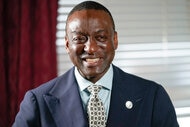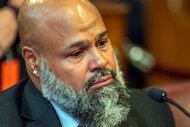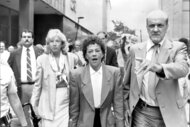Create a free profile to get unlimited access to exclusive videos, breaking news, sweepstakes, and more!
What Was the Extent Of The Central Park Jogger's Injuries?
Trisha Meili was hit in the back of the head and brutally raped and beaten while going for a jog in New York City's Central Park in the 1980s.

A 28-year-old jogger who was raped and beaten so badly she lost 80 percent of her blood in New York City in the late 1980s, setting off a chain of events that impacted many lives. She became known as the “Central Park Jogger” and the five men, just boys, who were wrongly convicted in connection with her rape became known as the “Central Park 5.”
The new Netflix miniseries "When They See Us" shows how investigators honed in on five teen boys who happened to be in the park at the time of the rape: Raymond Santana, Kevin Richardson, Antron McCray, Yusef Salaam, and Kharey Wise. They all maintained their innocence and said they were coerced into confessing. They were exonerated in 2002 after the real rapist came forward and admitted to the crime. Matias Reyes, known as the "East Side Rapist,” admitting to being behind the rape and investigators matched his DNA to the DNA at the crime scene, according to ABC News.
The jogger, Trisha Meili kept her identity secret for fourteen years, until a year after the exonerations.
She was an investment banker with two Masters degrees under her belt when she went for a jog in Central Park on April 19, 1989.
Meili was wearing headphones when she was attacked, according to "The Central Park Five: The Untold Story Behind One Of New York City's Most Infamous Crimes,” a book written in 2011 by Sarah Burns. She likely couldn’t hear her attacker approaching her and hitting her in the back of the head with a tree branch.
"Bleeding from the head, she was then dragged off the road to the north, through a grassy area, and then into the woods that began forty feet from the road,” the book states.
She was raped and beaten with a rock. Then, she was tied up with her own shirt and left to die.
Meili was barely alive when two passerbys found her. She was severely hurt, having had suffered several skull fractures and some deep lacerations. Her brain was swollen, and her body was jerking uncontrollably because of the injuries.
"I remember waking up in the hospital on a Friday evening late in May and a very good friend of mine was in the hospital room and so was a nurse," she testified during the 1990 trial, according to a Los Angeles Times story from that time.
After about a week in a coma she woke up with no memory of what happened to her.
"She had blunt trauma," surgeon Dr. Bob Kurtz, who treated Meili, told ABC News. "They didn’t know if she would survive. She looked like a little waif in the bed. No one knew who she was yet."
In addition to the skull fractures, her left eye had been crushed. One of the blows to her face caused her eyeball to burst. Another result of the blows to her head: a traumatic brain injury which damaged her physical and cognitive functioning.
Meili spent seven weeks in the ICU recovering during the aftermath, she told Shape last year. "I started to understand the gravity of my physical injuries when I realized I couldn't walk," says Meili. "My body felt heavy and movement was slow like I was going through mud or something."
When asked by a therapist to draw a picture of a clock, she couldn’t and that’s when she learned about her cognitive dysfunctioning.
"I thought I couldn't remember which hand was the big hand,” she said. “And felt this incredible fear of, 'Oh my God, I'm so stupid. I can't do this.' It was terrifying to realize that I wasn't the same. It was the first time I felt that so much had been taken away from me."
When she testified, as depicted in “When They See Us,” she had difficulty walking to the witness box. A court officer had to help her, grasping her elbow to keep her steady, the Los Angeles Times reported.
"I have problems with balance when I am walking and coordination at times as I am walking down the hall or down the street," she testified in 1990. "I'll veer off, either to the right or to the left. I also have a great deal of trouble going down steps . . . . I also have lost my sense of smell completely . . . I also suffer from double vision."
The jurors could barely look at the crime scene photo of her from the aftermath of her attack: her badly hurt body laying in blood and mud.
Exercise, the very event that was the precursor to her attacked, ending up helping Meili recover.
"As I kept moving and becoming physically stronger, I began seeing a positive impact on my cognitive rehabilitation as well,” she told Shape. “Down the road, I was even involved in a study about how running and exercise can do wonders for those with traumatic brain injuries."
Physically, she still bears some shadows of the attack. She still has some scarring on her face from the violent incident. She lost her sense of smell and struggles with both her sense of balance and vision, according to Refinery 29.
However, she has proven her strength both emotionally and physically. She never stopped running, joined a team for runners with disabilities just months after the attack, and even ran the New York Marathon back in 1995, the same year she got married. The New York Times did a profile on her dedication to running in 2009. She now works with survivors of sexual assault at Mount Sinai Hospital and Gaylord Hospital, according to Refinery 29. She also works with survivors of brain injuries, ABC News reports. In 2003, Meili revealed her identity to the public and published the memoir "I Am the Central Park Jogger: A Story of Hope and Possibility" under her own name.
"I thought this would be a good time to say, 'Hey, look. It’s been 20 years, and life doesn’t end after brain injury, after sexual assault or whatever our challenges are,' Meili told the New York Times at the time.
























